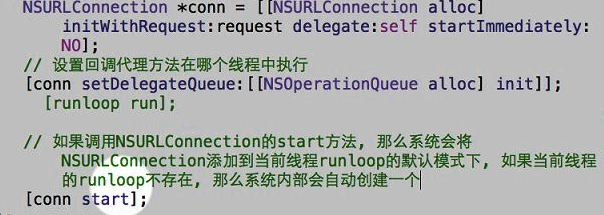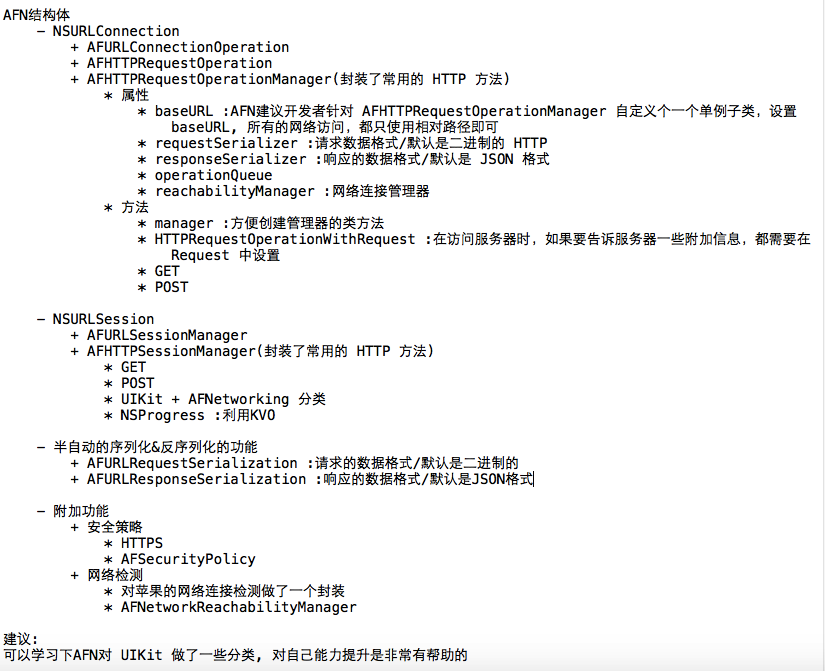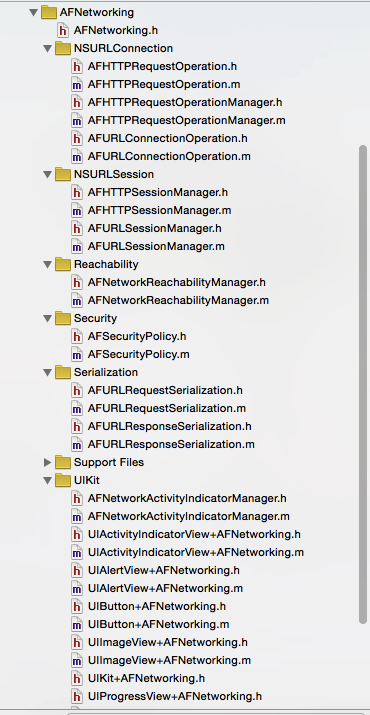一、NSURLConnection补充
前面提到的NSURLConnection有些知识点需要补充
NSURLConnectionDataDelegate的代理方法有一下几个
- (void)connection:(NSURLConnection *)connection didReceiveResponse:(NSURLResponse *)response { } - (void)connection:(NSURLConnection *)connection didReceiveData:(NSData *)data { } - (void)connectionDidFinishLoading:(NSURLConnection *)connection { } - (void)connection:(NSURLConnection *)connection didFailWithError:(NSError *)error { }
我们可以监听NSURLConnection的回调代理方法是在主线程中执行还是在子线程中执行?
默认情况下是在主线程中执行的
注意:
只要利用NSURLConnection发送一个请求, 那么系统会就自动将NSURLConnection加入到当前线程的RunLoop中
如果是在主线程中发送求情, 那么主线程的RunLoop永远存在, 所以NSURLConnection不会被释放
如果是在子线程中发送请求, 那么子线程默认没有RunLoop, 所以NSURLConnection会被释放
NSURLConnection在子线程发送请求时要手动添加到runloop中,否则局部变量会被释放

start方法会自动添加到runloop,如果没有会自动创建runloop,那么系统内部会自动创建一个

二、NSURLSession
1、NSURLSession
利用NSURLSession发送请求的使用步骤
- 创建NSURLSession
- 利用NSURLSession创建Task
- 执行Task
比如:
// 1.创建Session NSURLSession *session = [NSURLSession sharedSession]; // 2.根据Session创建Task NSURLSessionDownloadTask *task = [session downloadTaskWithRequest:request completionHandler:^(NSURL *location, NSURLResponse *response, NSError *error) { }]; // 3.执行Task [task resume];
Task的类型
2、获得NSURLSession
// 获得共享的Session + (NSURLSession *)sharedSession; // 自定义Session + (NSURLSession *)sessionWithConfiguration:(NSURLSessionConfiguration *)configuration; // 第一个参数:Session的配置信息 // 第二个参数: 代理 // 第三个参数: 决定了代理方法在哪个线程中执行 + (NSURLSession *)sessionWithConfiguration:(NSURLSessionConfiguration *)configuration delegate:(id <NSURLSessionDelegate>)delegate delegateQueue:(NSOperationQueue *)queue;
3、NSURLSessionTask常见方法
// 暂停 [self.task suspend]; // 继续 [self.task resume]; // 取消 // 注意点: 任务一旦取消, 就不能恢复了 [self.task cancel]; // 如果是调用cancelByProducingResumeData方法, 方法内部会回调一个block, 在block中会将resumeData传递给我们 // resumeData中就保存了当前下载任务的配置信息(下载到什么地方, 从什么地方恢复等等) [self.task cancelByProducingResumeData:^(NSData *resumeData) { self.resumeData = resumeData; }]; @property (readonly, copy) NSError *error; // 错误 @property (readonly, copy) NSURLResponse *response; // 响应
三、NSURLSession相关方法
1、NSURLSessionDataTask
// data: 服务器返回给我们的数据 // response : 响应头 // error: 错误信息 - (NSURLSessionDataTask *)dataTaskWithRequest:(NSURLRequest *)request completionHandler:(void (^)(NSData *data, NSURLResponse *response, NSError *error))completionHandler NS_CLASS_AVAILABLE(NSURLSESSION_AVAILABLE, 7_0); // 如果是通过传入url的方法创建Task, 方法内部会自动根据URL创建一个Request // 如果是发送Get请求, 或者不需要设置请求头信息, 那么建议使用当前方法发送请求 - (NSURLSessionDataTask *)dataTaskWithURL:(NSURL *)url completionHandler:(void (^)(NSData *data, NSURLResponse *response, NSError *error))completionHandler NS_CLASS_AVAILABLE(NSURLSESSION_AVAILABLE, 7_0);
2、NSURLSessionDownloadTask
// location: 下载好的文件在沙盒中的位置 // NSURLSessionDownloadTask已经默认帮我们实现了, 边下载边写入到沙盒 - (NSURLSessionDownloadTask *)downloadTaskWithRequest:(NSURLRequest *)request completionHandler:(void (^)(NSURL *location, NSURLResponse *response, NSError *error))completionHandler NS_CLASS_AVAILABLE(NSURLSESSION_AVAILABLE, 7_0); - (NSURLSessionDownloadTask *)downloadTaskWithURL:(NSURL *)url completionHandler:(void (^)(NSURL *location, NSURLResponse *response, NSError *error))completionHandler NS_CLASS_AVAILABLE(NSURLSESSION_AVAILABLE, 7_0); - (NSURLSessionDownloadTask *)downloadTaskWithResumeData:(NSData *)resumeData completionHandler:(void (^)(NSURL *location, NSURLResponse *response, NSError *error))completionHandler NS_CLASS_AVAILABLE(NSURLSESSION_AVAILABLE, 7_0);
3、NSURLSessionUploadTask
利用NSURLSessionUploadTask上传的步骤(和NSURLConnection类似)
3.1.创建URL NSURL *url = [NSURL URLWithString:@"http://120.25.226.186:32812/upload"]; 3.2.根据URL创建NSURLRequest NSMutableURLRequest *request = [NSMutableURLRequest requestWithURL:url]; 3.2.1设置请求头 request.HTTPMethod = @"POST"; [request setValue:@"multipart/form-data; boundary=分割线" forHTTPHeaderField:@"Content-Type"]; 3.2.2设置请求体 NSMutableData *data = [NSMutableData data]; 2.2.1设置文件参数 2.2.2设置非文件参数 2.2.3设置结束符号 request.HTTPBody = data; 3.3.利用NSURLConnetion发送请求 // 注意点: The body stream and body data in this request object are ignored. // 也就是说, 如果利用NSURLSessionUploadTask上传文件, 那么请求体必须写在fromData参数中, 不能设置在request中 // 如果设置在request中会被忽略 // request.HTTPBody = body; NSURLSession *session = [NSURLSession sharedSession]; NSURLSessionUploadTask *task = [session uploadTaskWithRequest:request fromData:body completionHandler:^(NSData *data, NSURLResponse *response, NSError *error) { }];
// 第一个参数: 需要请求的地址/请求头/请求体 // 第二个参数: 需要上传文件的URL // 注意:fromFile方法是用于PUT请求上传文件的 // 而我们的服务器只支持POST请求上传文件 - (NSURLSessionUploadTask *)uploadTaskWithRequest:(NSURLRequest *)request fromFile:(NSURL *)fileURL completionHandler:(void (^)(NSData *data, NSURLResponse *response, NSError *error))completionHandler NS_CLASS_AVAILABLE(NSURLSESSION_AVAILABLE, 7_0); - (NSURLSessionUploadTask *)uploadTaskWithRequest:(NSURLRequest *)request fromData:(NSData *)bodyData completionHandler:(void (^)(NSData *data, NSURLResponse *response, NSError *error))completionHandler NS_CLASS_AVAILABLE(NSURLSESSION_AVAILABLE, 7_0);
四、Data、下载、上传代理方法
1、NSURLSessionDataDelegate
// 接收到服务器的响应时调用 - (void)URLSession:(NSURLSession *)session dataTask:(NSURLSessionDataTask *)dataTask didReceiveResponse:(NSURLResponse *)response completionHandler:(void (^)(NSURLSessionResponseDisposition))completionHandler { // 注意: 在NSURLSessionDataTask的代理方法中, 默认情况下是不接受服务器返回的数据的, 所以didReceiveData方法和didCompleteWithError默认不会被调用 // 如果想接收服务器返回的数据, 必须手动的告诉系统, 我们需要接收数据 // void (^)(NSURLSessionResponseDisposition) // 返回值 (block)(参数) completionHandler(NSURLSessionResponseAllow); } // 接收到服务器返回的数据时调用 // data 此次接收到的数据 - (void)URLSession:(NSURLSession *)session dataTask:(NSURLSessionDataTask *)dataTask didReceiveData:(NSData *)data { } // 请求完毕时调用, 如果error有值, 代表请求错误 - (void)URLSession:(NSURLSession *)session task:(NSURLSessionTask *)task didCompleteWithError:(NSError *)error { }
2、NSURLSessionDownloadDelegate
// 接收到服务器返回的数据时调用 // 该方法会调用一次或多次 // didWriteData : 此次接收到的数据大小 // totalBytesWritten : 总共接收到的数据大小 // totalBytesExpectedToWrite : 服务器总共会返回给我们的文件大小 - (void)URLSession:(NSURLSession *)session downloadTask:(NSURLSessionDownloadTask *)downloadTask didWriteData:(int64_t)bytesWritten totalBytesWritten:(int64_t)totalBytesWritten totalBytesExpectedToWrite:(int64_t)totalBytesExpectedToWrite { } // 写入完成时调用 - (void)URLSession:(NSURLSession *)session downloadTask:(NSURLSessionDownloadTask *)downloadTask didFinishDownloadingToURL:(NSURL *)location { } // 恢复下载时调用 - (void)URLSession:(NSURLSession *)session downloadTask:(NSURLSessionDownloadTask *)downloadTask didResumeAtOffset:(int64_t)fileOffset expectedTotalBytes:(int64_t)expectedTotalBytes { } // 下载完成时调用 // 如果调用改方法时error有值, 代表着下载出现错误 - (void)URLSession:(NSURLSession *)session task:(NSURLSessionTask *)task didCompleteWithError:(NSError *)error { }
3、NSURLSessionTaskDelegate
// 上传过程中调用 // bytesSent: 当前这一次上传的数据大小 // totalBytesSent: 总共已经上传的数据大小 // totalBytesExpectedToSend: 需要上传文件的大小 - (void)URLSession:(NSURLSession *)session task:(NSURLSessionTask *)task didSendBodyData:(int64_t)bytesSent totalBytesSent:(int64_t)totalBytesSent totalBytesExpectedToSend:(int64_t)totalBytesExpectedToSend { // 计算上传进度 NSLog(@"%f", 1.0 * totalBytesSent / totalBytesExpectedToSend); } // 请求完毕时调用 - (void)URLSession:(NSURLSession *)session task:(NSURLSessionTask *)task didCompleteWithError:(NSError *)error { }
五、利用NSURLSession断点下载
#import "ViewController.h" #import "NSString+NJ.h" @interface ViewController ()<NSURLSessionDataDelegate> @property (weak, nonatomic) IBOutlet UIProgressView *progressView; - (IBAction)start:(UIButton *)sender; - (IBAction)pause:(UIButton *)sender; - (IBAction)goOn:(UIButton *)sender; @property (nonatomic, assign)NSUInteger totalLength; /**< 总大小 */ @property (nonatomic, assign)NSUInteger currentLength; /**< 当前已经下载的大小 */ @property (nonatomic, strong) NSOutputStream *outputStream ; /**< 输出流 */ @property (nonatomic, strong) NSURLSession *session; /**< session */ @property (nonatomic, strong) NSURLSessionDataTask *task; /**< 任务 */ @property (nonatomic, copy) NSString *path; /**< 文件路径 */ @end @implementation ViewController - (void)viewDidLoad { [super viewDidLoad]; // 初始化操作 // 1.初始化文件路径 self.path = [@"minion_02.mp4" cacheDir]; NSLog(@"%@",self.path); // 2.初始化当前下载进度 self.currentLength = [self getFileSizeWithPath:self.path]; } - (IBAction)start:(UIButton *)sender { // 3.执行Task [self.task resume]; } - (IBAction)pause:(UIButton *)sender { [self.task suspend]; } - (IBAction)goOn:(UIButton *)sender { [self.task resume]; } // 根据路径获取文件大小 - (NSUInteger)getFileSizeWithPath:(NSString *)path { NSUInteger currentSize = [[[NSFileManager defaultManager] attributesOfItemAtPath:path error:nil][NSFileSize] integerValue]; return currentSize; } #pragma mark - NSURLSessionDataDelegate // 接收到服务器的响应时调用 - (void)URLSession:(NSURLSession *)session dataTask:(NSURLSessionDataTask *)dataTask didReceiveResponse:(NSURLResponse *)response completionHandler:(void (^)(NSURLSessionResponseDisposition))completionHandler { NSLog(@"didReceiveResponse"); // 告诉系统需要接收数据 completionHandler(NSURLSessionResponseAllow); // 初始化文件总大小 self.totalLength = response.expectedContentLength + [self getFileSizeWithPath:self.path]; // 打开输出流 self.outputStream = [NSOutputStream outputStreamToFileAtPath:self.path append:YES]; [self.outputStream open]; } // 接收到服务器返回的数据时调用 // data 此次接收到的数据 - (void)URLSession:(NSURLSession *)session dataTask:(NSURLSessionDataTask *)dataTask didReceiveData:(NSData *)data { // NSLog(@"didReceiveData"); // 累加已经下载的大小 self.currentLength += data.length; // 计算进度 self.progressView.progress = 1.0 * self.currentLength / self.totalLength; // 写入数据 [self.outputStream write:data.bytes maxLength:data.length]; } // 请求完毕时调用, 如果error有值, 代表请求错误 - (void)URLSession:(NSURLSession *)session task:(NSURLSessionTask *)task didCompleteWithError:(NSError *)error { NSLog(@"didCompleteWithError"); // 关闭输出流 [self.outputStream close]; } #pragma mark - lazy - (NSURLSession *)session { if (!_session) { // 1.创建Session _session = [NSURLSession sessionWithConfiguration:[NSURLSessionConfiguration defaultSessionConfiguration] delegate:self delegateQueue:[NSOperationQueue mainQueue]]; } return _session; } - (NSURLSessionDataTask *)task { if (!_task) { NSURL *url = [NSURL URLWithString:@"http://120.25.226.186:32812/resources/videos/minion_02.mp4"]; NSMutableURLRequest *request = [NSMutableURLRequest requestWithURL:url]; // 设置请求头 NSString *range = [NSString stringWithFormat:@"bytes:%zd-", [self getFileSizeWithPath:self.path]]; [request setValue:range forHTTPHeaderField:@"Range"]; _task = [self.session dataTaskWithRequest:request]; } return _task; } @end
六、AFN基本使用
1、AFN简介

// 1.创建AFN管理者 AFHTTPRequestOperationManager *manager = [AFHTTPRequestOperationManager manager]; // 2.利用AFN管理者发送请求 /* 第1个参数: 需要请求的URL地址字符串 第2个参数: 请求时需要传递的参数 第3个参数: 请求成功的回调 第4个参数: 请求失败的回调 */ // 注意: 字典参数中不需要写? , AFN会自动添加 NSDictionary *dict = @{ @"username":@"520it", @"pwd":@"520it", @"type":@"JSON", }; [manager GET:@"http://120.25.226.186:32812/login" parameters:dict success:^(AFHTTPRequestOperation *operation, id responseObject) { // responseObject 服务器返回的数据 // 注意点: 如果服务器返回的是JSON, AFN会自动转换为OC对象 NSLog(@"%@", responseObject); } failure:^(AFHTTPRequestOperation *operation, NSError *error) { NSLog(@"error"); }];
POST
// 1.创建AFN管理者 AFHTTPRequestOperationManager *manager = [AFHTTPRequestOperationManager manager]; // 2.利用AFN管理者发送请求 NSDictionary *dict = @{ @"username":@"520it", @"pwd":@"520it", @"type":@"JSON", }; [manager POST:@"http://120.25.226.186:32812/login" parameters:dict success:^(AFHTTPRequestOperation *operation, id responseObject) { NSLog(@"%@", responseObject); } failure:^(AFHTTPRequestOperation *operation, NSError *error) { NSLog(@"error"); }];
3、AFN对NSURLSession封装
GET
// 1.创建AFN管理者 AFHTTPSessionManager *manager = [AFHTTPSessionManager manager]; // 2.利用AFN发送请求 NSDictionary *dict = @{ @"username":@"520it", @"pwd":@"520it", @"type":@"JSON", }; [manager GET:@"http://120.25.226.186:32812/login" parameters:dict success:^(NSURLSessionDataTask *task, id responseObject) { NSLog(@"%@", responseObject); } failure:^(NSURLSessionDataTask *task, NSError *error) { NSLog(@"error"); }];
POST
// 1.创建AFN管理者 AFHTTPSessionManager *manager = [AFHTTPSessionManager manager]; // 2.利用AFN发送请求 NSDictionary *dict = @{ @"username":@"520it", @"pwd":@"520it", @"type":@"JSON", }; [manager POST:@"http://120.25.226.186:32812/login" parameters:dict success:^(NSURLSessionDataTask *task, id responseObject) { NSLog(@"%@", responseObject); } failure:^(NSURLSessionDataTask *task, NSError *error) { NSLog(@"error"); }];
4、使用AFN下载文件
// 1.创建AFN管理者 AFHTTPSessionManager *manager = [AFHTTPSessionManager manager]; // 2.利用AFN下载文件 NSURLRequest *request = [NSURLRequest requestWithURL:[NSURL URLWithString:@"http://120.25.226.186:32812/resources/images/minion_02.png"]]; NSURLSessionDownloadTask *task = [manager downloadTaskWithRequest:request progress:nil destination:^NSURL *(NSURL *targetPath, NSURLResponse *response) { // 请求完成的回调 // targetPath : 下载好的文件的路径 // response: 响应头 // block的返回值: 告诉AFN框架, 是否需要将下载好的文件移动到其它路径下 NSLog(@"targetPath = %@", targetPath); NSString *path = [response.suggestedFilename cacheDir]; NSURL *destURL = [NSURL fileURLWithPath:path]; NSLog(@"destURL = %@", destURL); return destURL; } completionHandler:^(NSURLResponse *response, NSURL *filePath, NSError *error) { // 下载完成的回调 // filePath : 移动之后的文件路径 NSLog(@"filePath = %@", filePath); }]; [task resume];
监听下载进度
在NSProgress有两个属性
@property int64_t totalUnitCount; 需要下载文件的总大小
@property int64_t completedUnitCount; 已经下载文件的总大小
使用KVO进行监听completedUnitCount值的变化
- (void)download2 { // 1.创建AFN管理者 AFHTTPSessionManager *manager = [AFHTTPSessionManager manager]; NSProgress *progress = nil; self.progress = progress; // 2.利用AFN下载文件 NSURLRequest *request = [NSURLRequest requestWithURL:[NSURL URLWithString:@"http://120.25.226.186:32812/resources/videos/minion_02.mp4"]]; // 只要将NSProgress对象传递给AFN, AFN就会在内部自动给NSProgress赋值 会自动修改NSProgress的下载进度 NSURLSessionDownloadTask *task = [manager downloadTaskWithRequest:request progress:&progress destination:^NSURL *(NSURL *targetPath, NSURLResponse *response) { // 请求完成的回调 NSString *path = [response.suggestedFilename cacheDir]; NSURL *destURL = [NSURL fileURLWithPath:path]; return destURL; } completionHandler:^(NSURLResponse *response, NSURL *filePath, NSError *error) { // 下载完成的回调 // filePath : 移动之后的文件路径 NSLog(@"filePath = %@", filePath); }]; // 给NSProgress注册监听, 监听它的completedUnitCount属性的改变 [progress addObserver:self forKeyPath:@"completedUnitCount" options:NSKeyValueObservingOptionNew context:nil]; // 注意: 必须手动执行才会开始下载 [task resume]; }
- (void)dealloc { [self removeObserver:self.progress forKeyPath:@"completedUnitCount"]; }
- (void)observeValueForKeyPath:(NSString *)keyPath ofObject:(id)object change:(NSDictionary *)change context:(void *)context { if ([object isKindOfClass:[NSProgress class]]) { NSProgress *progress = (NSProgress *)object; // 计算下载进度 NSLog(@"%f", 1.0 * progress.completedUnitCount / progress.totalUnitCount); } }
5、AFN上传文件
// 1.创建AFN管理者 AFHTTPSessionManager *manager = [AFHTTPSessionManager manager]; // 2.利用AFN上传文件 NSDictionary *dict = @{ @"username":@"lnj" }; [manager POST:@"http://120.25.226.186:32812/upload" parameters:dict constructingBodyWithBlock:^(id<AFMultipartFormData> formData) { // 在这个block中上传文件数据 // formData就是专门用于保存需要上传文件的二进制数据的 NSData *data = [NSData dataWithContentsOfFile:@"/Users/chg/Desktop/胸小别讲话.jpg"]; // 注意: 该方法不能用于POST上传 // [formData appendPartWithFormData:data name:@"file"]; /* 第一个参数: 需要上传的文件二进制 第二个参数: 服务器对应的参数名称 第三个参数: 文件的名称 第四个参数: 文件的MIME类型 */ // [formData appendPartWithFileData:data name:@"file" fileName:@"abc.png" mimeType:@"image/png"]; /* 第一个参数: 需要上传的文件的URL 第二个参数: 服务器对应的参数名称 第三个参数: 文件的名称 第四个参数: 文件的MIME类型 */ NSURL *url = [NSURL fileURLWithPath:@"/Users/chg/Desktop/胸小别讲话.jpg"]; // [formData appendPartWithFileURL:url name:@"file" fileName:@"def.png" mimeType:@"image/png" error:nil]; // 如果使用以下方法上传文件, AFN会自动获取文件的名称和类型 [formData appendPartWithFileURL:url name:@"file" error:nil]; } success:^(NSURLSessionDataTask *task, id responseObject) { NSLog(@"成功的回调 %@", responseObject); } failure:^(NSURLSessionDataTask *task, NSError *error) { NSLog(@"失败的回调"); }];
6、AFN序列化
// 1.创建AFN管理者 AFHTTPSessionManager *manager = [AFHTTPSessionManager manager]; // 如果服务器返回的不是JSON数据, 那么需要提前告诉AFN如何处理处理数据 // 只要给AFN的responseSerializer属性, 赋值为AFXMLParserResponseSerializer, 以后AFN就会将服务器返回的数据当做XML来处理 // manager.responseSerializer = [AFXMLParserResponseSerializer serializer]; // 只要给AFN的responseSerializer属性, 赋值为AFHTTPResponseSerializer, 以后AFN就会将服务器返回的数据当做二进制来处理, 也就是说不做任何处理 // manager.responseSerializer = [AFHTTPResponseSerializer serializer]; // 2.利用AFN发送请求 NSDictionary *dict = @{ @"username":@"520it", @"pwd":@"520it", @"type":@"XML", }; [manager POST:@"http://120.25.226.186:32812/resources/images/minion_02.png" parameters:nil success:^(NSURLSessionDataTask *task, id responseObject) { // 注意: AFN默认会将服务器返回的数据当做JSON处理 // 如果服务器返回的是JSON数据, 那么会自动转换为OC对象 NSLog(@"%@", responseObject); // 只要设置AFN的responseSerializer为XML, 那么返回的responseObject就是NSXMLParser解析器 } failure:^(NSURLSessionDataTask *task, NSError *error) { NSLog(@"error"); }];
7、网络检测
// 1.创建网络监听管理者 AFNetworkReachabilityManager *manager = [AFNetworkReachabilityManager sharedManager]; // 2.设置网络变化的回调 [manager setReachabilityStatusChangeBlock:^(AFNetworkReachabilityStatus status) { // 只要用户的网络发生改变, 就会调用这个block /* AFNetworkReachabilityStatusUnknown = 不能识别, AFNetworkReachabilityStatusNotReachable = 没有网络, AFNetworkReachabilityStatusReachableViaWWAN = 蜂窝网, AFNetworkReachabilityStatusReachableViaWiFi = 局域网, */ switch (status) { case AFNetworkReachabilityStatusReachableViaWWAN: NSLog(@"蜂窝网"); break; case AFNetworkReachabilityStatusReachableViaWiFi: NSLog(@"局域网"); break; case AFNetworkReachabilityStatusNotReachable: NSLog(@"没有网络"); break; default: NSLog(@"不能识别"); break; } }]; // 3.开始监听 [manager startMonitoring];
苹果的有个类(Reachability)用于检测网络
这个类需要自己下载

如果要检测当前网络可以这样实现
- (void)viewDidLoad { [super viewDidLoad]; // 1.创建Reachability对象 self.r1 = [Reachability reachabilityForLocalWiFi]; // 2.给Reachability对象注册通知 [[NSNotificationCenter defaultCenter] addObserver:self selector:@selector(getNetworkStatus) name:kReachabilityChangedNotification object:nil]; // 3.让Reachability对象发送网络改变的通知 [self.r1 startNotifier]; } - (void)dealloc { [[NSNotificationCenter defaultCenter] removeObserver:self]; } - (void)getNetworkStatus { if ([Reachability reachabilityForLocalWiFi].currentReachabilityStatus != NotReachable) { NSLog(@"当前是WiFi"); }else if ([Reachability reachabilityForInternetConnection].currentReachabilityStatus != NotReachable) { NSLog(@"当前是蜂窝网"); }else { NSLog(@"没有网络"); } }
8、总结
总的来说AFN框架分为5大块,通过下面这张图可以一目了然

通过cocoapods更新该框架也可以看到作者已经为这个框架的类用文件夹分好了,有助于我们阅读
